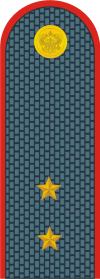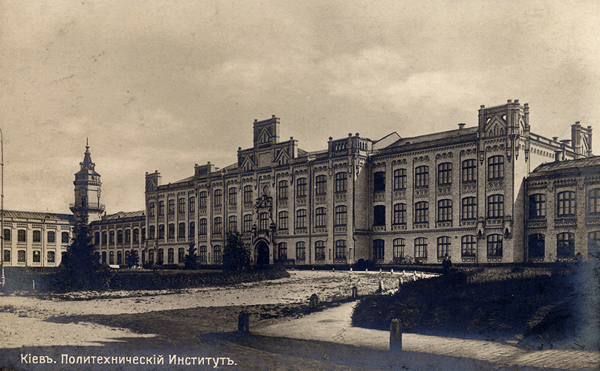|
Kazys Ladyga
Kazys Ladiga or Ladyga (6 January 1894 – 19 December 1941) was a Lithuanian general and one of the first volunteer officers of the Lithuanian Army. Upon graduating from the Military Academy in Vilnius, Ladiga served in the Imperial Russian Army during World War I and earned the rank of captain. He returned to Lithuania in 1918 and volunteered to the newly formed Lithuanian Army. He was appointed as the commander of the 1st Infantry Regiment. Ladiga quickly rose through the ranks and commanded the Vilkmergė Group in the Lithuanian–Soviet War. He also led units in the Lithuanian–Bermontian War ( Battle of Radviliškis) and in the Polish–Lithuanian War (Battle of Sejny). After an unsuccessful campaign in September 1920, Ladiga was demoted to commander of the 4th Infantry Division. After the Lithuanian Wars of Independence, he continued military studies in Switzerland and Czechoslovakia. He rose to the rank of a general and briefly served as the Chief of the General Staff ... [...More Info...] [...Related Items...] OR: [Wikipedia] [Google] [Baidu] |
Russian Empire
The Russian Empire was an empire that spanned most of northern Eurasia from its establishment in November 1721 until the proclamation of the Russian Republic in September 1917. At its height in the late 19th century, it covered about , roughly one-sixth of the world's landmass, making it the list of largest empires, third-largest empire in history, behind only the British Empire, British and Mongol Empire, Mongol empires. It also Russian colonization of North America, colonized Alaska between 1799 and 1867. The empire's 1897 census, the only one it conducted, found a population of 125.6 million with considerable ethnic, linguistic, religious, and socioeconomic diversity. From the 10th to 17th centuries, the Russians had been ruled by a noble class known as the boyars, above whom was the tsar, an absolute monarch. The groundwork of the Russian Empire was laid by Ivan III (), who greatly expanded his domain, established a centralized Russian national state, and secured inde ... [...More Info...] [...Related Items...] OR: [Wikipedia] [Google] [Baidu] |
Lithuanian–Soviet War
The Lithuanian–Soviet War or Lithuanian–Bolshevik War () was fought between newly independent Lithuania and the Russian Socialist Federative Soviet Republic in the aftermath of World War I. It was part of the larger Soviet westward offensive of 1918–1919. The offensive followed the retreat of German troops and sought to establish Soviet republics in Ukraine, Belarus, Lithuania, Latvia, Estonia, Poland and link up with the German Revolution. By the end of December 1918 Soviet forces reached Lithuanian borders. Largely unopposed, they occupied one town after another and by the end of January 1919 controlled about two thirds of the Lithuanian territory. In February, the Soviet advance was stopped by Lithuanian and German volunteers, who prevented the Soviets from capturing Kaunas, the temporary capital of Lithuania. From April 1919, the Lithuanian war went parallel with the Polish–Soviet War. Poland had territorial claims over Lithuania, especially the Vilnius Region; these ... [...More Info...] [...Related Items...] OR: [Wikipedia] [Google] [Baidu] |
18th Infantry Division (Russian Empire)
The 18th Infantry Division (, ''18-ya Pekhotnaya Diviziya'') was an infantry formation of the Russian Imperial Army during World War I and the Russian Civil War. It was formed in 1806 as the 10th Infantry Division. It was renumbered in several subsequent reorganizations, becoming the 15th in 1820, the 12th in 1833, and the 18th in 1835. By 1914 it was part of the 14th Army Corps at Lublin. Organization *1st Brigade (Lublin) **69th Ryazan Infantry Regiment (Lublin) **70th Ryazhsk Infantry Regiment (Siedlce) *2nd Brigade (Ivangorod) **71st Belyov Infantry Regiment ( Novaya Aleksandria) **72nd Tula Infantry Regiment (Ivangorod) *18th Artillery Brigade Commanders *1901-1906: Vladimir Vasilyevich Smirnov *1907-1908: Yakov Schkinsky Yakov Federovich Shkinsky (4 June 1858 – 22 April 1938) was an Imperial Russian division and corps commander. He fought in the wars against the Ottoman Empire and the Empire of Japan. After the October Revolution, he fought against the Bolshev ... ... [...More Info...] [...Related Items...] OR: [Wikipedia] [Google] [Baidu] |
Praporshchik
(, , ) is a rank used by the Russian Armed Forces and a number of former communist states. The rank is a non-commissioned officer's and is equivalent to in the corresponding navies. It is usually equivalent to warrant officer class 1 or sergeant major in English-speaking armies. Within NATO forces, the rank is rated as OR-7 or OR-8. Russia is a rank in the Russian military, also used in other uniformed services of the Russian government such as the police. It was a junior officer rank in Imperial Russia, but was abolished following the Russian Revolution. In 1940, the rank was restored as a separate career group between non-commissioned officers and officers. Imperial Russia was originally an Oberoffizer rank, as first introduced in Streltsy New Regiments. The name originates from Slavonic ''prapor'' (прапор), meaning flag; the ''praporshchik'' was a flag-bearer in Kievan Rus troops. In the New Regiments of the Streltsy and the "new army" of Peter the Great, '' ... [...More Info...] [...Related Items...] OR: [Wikipedia] [Google] [Baidu] |
Kyiv Polytechnic Institute
The Kyiv Polytechnic Institute ( KPI, ; official full title National Technical University of Ukraine "Igor Sikorsky Kyiv Polytechnic Institute") is a national public technological university in Kyiv, Ukraine. Name In the long period of existence, the name of the institute has changed several times: * 1898–1918 Kiev Polytechnic Institute of Emperor Alexander II * 1918–1934 Kyiv Polytechnic Institute * 1934–1948 Kyiv Industrial Institute * 1948–1968 Order of Lenin Kyiv Polytechnic Institute * 1968–1992 Order of Lenin Kyiv Polytechnic Institute in memory of the 50th anniversary of the Great October Socialist Revolution * 1992–1995 Kyiv Polytechnic Institute * 1995–2016 National Technical University of Ukraine "Kyiv Polytechnic Institute" * 2016– National Technical University of Ukraine "Igor Sikorsky Kyiv Polytechnic Institute" History Establishment The institute was founded as the Kiev Polytechnic Institute of Emperor Alexander II on 31 August 1898. Its establish ... [...More Info...] [...Related Items...] OR: [Wikipedia] [Google] [Baidu] |
Aušrininkai
''Aušrininkai'' was a semi-formal socialist student movement in Lithuania that formed around the ''Aušrinė'' (morning star) magazine. Established in 1910, it was the first youth organization in Lithuania. Student groups formed in various schools that organized discussions, lectures, literature exchanges, etc. These groups did not have any central leadership and acted mostly on their own based on principles outlined in ''Aušrinė''. Initially a non-political magazine, established with a long-term aim of developing the new generation of intelligentsia, it soon stated propagating ideas of the Russian Narodniks and Socialist Revolutionary Party. During World War I, the schools and students evacuated to Russia, mainly Voronezh, and the organization became a lot more political. However, Marxism was rejected in favor of individualism. Upon return to Lithuania in 1918, the organization was able to work legally for a few years. The Lithuanian government considered communists dangerous ... [...More Info...] [...Related Items...] OR: [Wikipedia] [Google] [Baidu] |
Biržai
Biržai (, also known by several alternative names) is a city in northern Lithuania. Famous for its reconstructed Biržai Castle manor, the whole region is renowned for its many traditional-recipe beer breweries. Name The exact origin of the city name is not known, but it is derived from the Lithuanian word (which means ''birch''). The name of the city in other languages includes ; , (and pre-1917 ); . It is simplified to ''Birzai'' in English. History The city's first written mention dates to 1455. The construction of Biržai Castle began in 1586, and the town was granted Magdeburg Rights in 1589. In 1575, as preparation for the castle's construction, a dam was built at the confluence of the Agluona and Apaščia Rivers, and the artificial Lake Širvėna, covering about , was created. It is the oldest surviving artificial lake in Lithuania. The town's history is closely associated with the Radziwiłł family (Lithuanian: Radvila). Jerzy Radziwiłł was the firs ... [...More Info...] [...Related Items...] OR: [Wikipedia] [Google] [Baidu] |
Soviet Occupation Of Lithuania (1940)
The occupation of the Baltic states was a period of annexation of Estonia, Latvia and Lithuania by the Soviet Union from 1940 until its dissolution in 1991. For a period of several years during World War II, Nazi Germany occupied the Baltic states after it invaded the Soviet Union in 1941. The initial Soviet invasion and occupation of the Baltic states began in June 1940 under the Molotov–Ribbentrop Pact, made between the Soviet Union and Nazi Germany in August 1939 before the outbreak of World War II. The three independent Baltic countries were annexed as constituent Republics of the Soviet Union in August 1940. Most Western countries did not recognise this annexation, and considered it illegal. In July 1941, the occupation of the Baltic states by Nazi Germany took place, just weeks after its invasion of the Soviet Union. The Third Reich incorporated them into its ''Reichskommissariat Ostland''. In 1944, the Soviet Union recaptured most of the Baltic states as a result ... [...More Info...] [...Related Items...] OR: [Wikipedia] [Google] [Baidu] |
1926 Lithuanian Coup D'état
The 1926 Lithuanian coup d'état ( Lithuanian: ) was a military coup d'état in Lithuania that replaced the democratically elected government with a authoritarian regime led by Antanas Smetona. The coup took place on 17 December 1926 and was largely organized by the military; Smetona's role remains the subject of debate. The coup brought the Lithuanian Nationalist Union, the most conservative party at the time, to power. Previously it had been a fairly new and insignificant nationalistic party. By 1926, its membership reached about 2,000 and it had won only three seats in the parliamentary elections. The Lithuanian Christian Democratic Party, the largest party in the Seimas at the time, collaborated with the military and provided constitutional legitimacy to the coup, but accepted no major posts in the new government and withdrew in May 1927. After the military handed power over to the civilian government, it ceased playing a direct role in political life. Background Lithu ... [...More Info...] [...Related Items...] OR: [Wikipedia] [Google] [Baidu] |
Czechoslovakia
Czechoslovakia ( ; Czech language, Czech and , ''Česko-Slovensko'') was a landlocked country in Central Europe, created in 1918, when it declared its independence from Austria-Hungary. In 1938, after the Munich Agreement, the Sudetenland became part of Nazi Germany, while the country lost further territories to First Vienna Award, Hungary and Trans-Olza, Poland (the territories of southern Slovakia with a predominantly Hungarian population to Hungary and Zaolzie with a predominantly Polish population to Poland). Between 1939 and 1945, the state ceased to exist, as Slovak state, Slovakia proclaimed its independence and Carpathian Ruthenia became part of Kingdom of Hungary (1920–1946), Hungary, while the German Protectorate of Bohemia and Moravia was proclaimed in the remainder of the Czech Lands. In 1939, after the outbreak of World War II, former Czechoslovak President Edvard Beneš formed Czechoslovak government-in-exile, a government-in-exile and sought recognition from the ... [...More Info...] [...Related Items...] OR: [Wikipedia] [Google] [Baidu] |
Switzerland
Switzerland, officially the Swiss Confederation, is a landlocked country located in west-central Europe. It is bordered by Italy to the south, France to the west, Germany to the north, and Austria and Liechtenstein to the east. Switzerland is geographically divided among the Swiss Plateau, the Swiss Alps, Alps and the Jura Mountains, Jura; the Alps occupy the greater part of the territory, whereas most of the country's Demographics of Switzerland, 9 million people are concentrated on the plateau, which hosts List of cities in Switzerland, its largest cities and economic centres, including Zurich, Geneva, and Lausanne. Switzerland is a federal republic composed of Cantons of Switzerland, 26 cantons, with federal authorities based in Bern. It has four main linguistic and cultural regions: German, French, Italian and Romansh language, Romansh. Although most Swiss are German-speaking, national identity is fairly cohesive, being rooted in a common historical background, shared ... [...More Info...] [...Related Items...] OR: [Wikipedia] [Google] [Baidu] |


